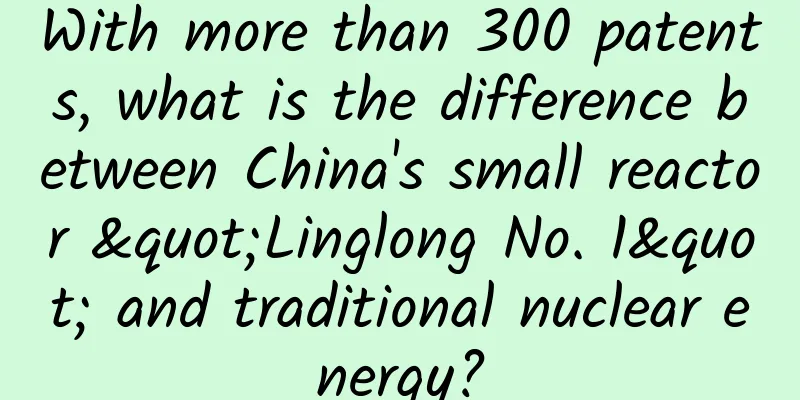With more than 300 patents, what is the difference between China's small reactor "Linglong No. 1" and traditional nuclear energy?

|
Since China's nuclear energy development started relatively late, standards, patents and markets have long been in the hands of European and American countries. However, this situation has now changed, and the change was triggered by China's small reactor "Linglong No. 1". What is a small reactor? Nuclear energy is essentially a clean and efficient energy source, but it also has a fatal drawback, that is safety. In the 20 years from 1966 to 1986 alone, at least three major nuclear accidents occurred internationally, namely the Parimares hydrogen bomb accident, the Three Mile Island nuclear power plant accident, and the Chernobyl nuclear power plant accident that shocked the world. In order to improve the safety of nuclear energy use, the International Atomic Energy Agency proposed that nuclear reactors should be developed towards miniaturization. Miniaturizing nuclear reactors is a completely new technological field for any country in the world. Because miniaturizing a nuclear reactor is not simply shrinking the original large nuclear power plant, because the electricity consumption logic of the two is completely different. When building a large nuclear power plant, there is no need to consider the purpose. We just build it and directly connect it to the national power grid after it is built. We can send it wherever it is needed. But the construction of a small reactor must fully consider the environment and purpose of the corresponding area. It is a completely new type of reactor that integrates multiple technologies. Against this background, many countries in the world have begun research on small nuclear reactors. Whether it is Russia and Japan, the United Kingdom and France in Europe, or the United States on the other side of the Pacific Ocean, they have all invested huge amounts of money in the research of small reactors. my country began exploring small multi-purpose reactors in 2003, and in 2009, China National Nuclear Corporation formally proposed a differentiated strategy for the layout of small nuclear reactors. Soon after, with the occurrence of the Fukushima nuclear leak, the international call for improving the safety of nuclear reactors further increased, so in 2011, China National Nuclear Corporation officially launched the modular small reactor project, code-named ACP100, also known as Linglong No. 1. The emergence of Linglong-1 can be said to have changed the world's nuclear energy landscape to a certain extent. Why do you say that? Because Linglong No. 1 is not only a small nuclear reactor, but more accurately, it should be a small multifunctional modular nuclear reactor. First of all, in order to minimize the size of the nuclear power plant, Linglong No. 1 adopts an integrated design. We know that the normal operation of a nuclear power plant is the result of the cooperation of many components, such as fuel assemblies, steam generators, etc. These components are connected by pipes, which will make the nuclear power plant very large. Secondly, there will be some potential risks, because the more pipes there are, the easier it is to rupture due to accidents. Linglong No. 1 adopts an integrated design, which minimizes unnecessary pipes and uses short nozzles to connect various components. This not only reduces the size but also improves safety. So how safe is Linglong No. 1? If an accident occurs, the core can be protected by itself for minor accidents, and the emergency range can be reduced to within 300 meters for major accidents. Secondly, Linglong No. 1 adopts a modular design, that is, all equipment can be mass-produced on the assembly line, and then assembled like building blocks. This means that Linglong No. 1 can be quickly replicated, minimizing production costs. Finally, there is the multifunctional design. Linglong No. 1 has a very wide range of applications. Unlike traditional nuclear power plants, it can be built in remote areas. It can be built even near cities. It can directly replace thermal power plants and become the main force for powering cities. In addition, it can be built in mountainous areas, at sea, and even in space. Most importantly, Linglong No. 1 has more than 300 patents and has a completely independent voice in the industry. It will not be strangled by anyone. This lays the foundation for us to open the door to the world market in the future. I believe that with the technical advantages of Linglong No. 1's low cost and fast production, its future development is very promising. It has not only changed China's nuclear power status in the world, but also had a profound impact on the world's nuclear energy pattern. |
<<: Let’s go and see the Grand Canal!
>>: There is new news about China’s moon landing program!
Recommend
What are the medicinal values of Ganoderma lucidum
Ganoderma lucidum is a type of fungus that is wid...
The efficacy and function of mountain shell bone
As we all know, mountain shell bone is a very com...
Can mugwort be eaten?
Artemisia, also known as wormwood, is a perennial...
How to distinguish true and false red ginseng
Red ginseng is a skin care product, and many peop...
Many people like this in winter, but this kind of wine really can’t be drunk casually!
Winter sun warm It’s the right time for a wild ou...
Did you know that glasses cloth is not used to clean glasses?
I believe that many friends who wear glasses do t...
The efficacy and function of poplar bark
The white bark of poplar wood is a traditional Ch...
The efficacy and function of rootless vine
What are the effects and functions of rootless vi...
The efficacy and function of garlic stems
Garlic stems are a traditional Chinese medicine. ...
The efficacy and function of Acer palmatum
Acer truncatum is a very common and frequently us...
What are the effects and functions of Morinda officinalis
Morinda officinalis is a two-leaf plant, mainly p...
Actually, we are all stars.
© CC BY 4.0 Leviathan Press: I forgot where I saw...
The efficacy and functions of white peony flower, white peony is the best match for it!
Many people don’t know much about white peony flo...
Black Bear Bile Powder
We all get sick, and when we are sick, our bodies...
Why does your phone become slower and slower as you use it? It may be because of these small operations in daily life
Planning and production Source: Curious Doctor Ed...









